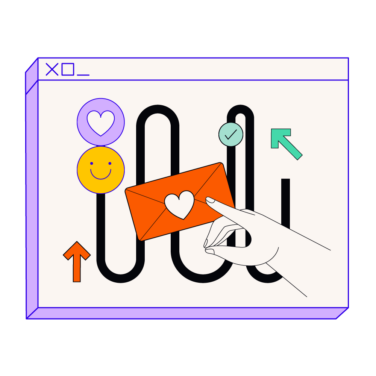If you’re wondering whether your company should invest in customer experience vs user experience, keep in mind that customer experience is the biggest competition factor for 89% of businesses. But is the CX vs. UX distinction real, or just words?
Yes, there are real differences between customer experience and user experience. You’ll have to understand the distinction in order to maximize one as much as the other. Here's the difference between customer and user experience, along with a few kindergartner-friendly translations, plus more ado on how to create the best experiences for your customers.
Customer Experience (CX) vs. User Experience (UX)
So why do customer and user experience sound so similar? It’s because UX is part of CX. Despite being a newer idea, customer experience is the "parent" of user experience. Think of CX as the umbrella term, and all the components that go into delivering customer experiences fit under that umbrella—including things like customer service, support, and—you guessed it—user experience.
Because customer experience is so encompassing, it’s just as important to understand how to create good CX as well as good UX.
Explain Like I'm Five [ELI5]: Customer experience is like a big house, and user experience is one of the rooms in the house.
What is customer experience, exactly?
Customer experience is the overall experience that a customer has when interacting with your brand. Everything from the smooth learning processes in the customer journey, to the capable and courteous customer service, to the look and feel of your website and physical stores (if you have them)— everything improves customer experience.
Customer experience brings together every impression the customer receives from all of your company's touchpoints.
ELI5: The customer experience "house" represents everything there is for a customer to see, hear, feel, and do when they're visiting with your company—just like how your house has lots to see and do when your friends come over for dinner.
And what is user experience?
User experience is more narrow in focus. UX focuses mainly on the product. For companies with several products, each product may have its own UX. Are they easy to use? Are they pleasant to look at or navigate? Do they do what customers need?
The website, help pages or frequently asked questions (FAQ) can also consider UX. Are these pages easy to navigate? Do they feel good to use? Do they lead users to where both they and the company want them to go?
Each product and many communication channels will have their own user experience, though they should share some consistent attributes to maintain a sense of brand identity.
ELI5: Now, imagine the user experience is the dining room where the dinner is being served. Your guests will expect to have everything they need to eat with you, like forks and plates, and they hopefully like the food enough that they'll want to come over again.
CX is Brand. UX is Product.
The distinction of CX vs. UX is non-trivial. CX considers a much broader umbrella of every experience a customer has interacting with your product, sales, and service. UX—or the UX of each product and communication channel—is just one group of considerations under the broader CX umbrella. Working on UX alone would give an incomplete picture of what it’s like to deal with your company.
Another reason why the difference between CX and UX is important is because, for some companies, the customer of your brand is not always the end user of your products. Larger firms may have a manager or director who decides what products to supply their team members… hopefully with their input! In cases where the customer or buying decision maker is not the same as the user, the distinction between CX and UX is even more clear.
ELI5: The customer and the user aren't always the same person. A school and librarian may decide which products to buy for the teachers and students to use. Or, some parents might buy an iPad for their kids to play with.
Now that we've covered the basics at an elementary-school level, let's dive deeper into the significance of both concepts.
Role and Importance of CX
New companies may neglect the customer experience to focus on the user experience of their minimum viable product (MVP). But there are many reasons why you should plan to start paying attention to CX as soon as possible.
CX helps customers decide whether you’re a good company
Customer experience has a more holistic role to play in showing the customer that you’re a company worth doing business with. Product alone doesn’t build a good company. You can have the best user experience in the world, but if the other features of your customer experience are poorly thought out, unpleasant, or hard to deal with, you may still lose out on customers who aren’t fans of your brand.
Primary goals of CX
Of course, product, or user experience, is one of the most important goals within the CX umbrella. You have to have a good product in order for your company to matter at all. But other CX goals are also a high priority in ensuring customers have the best possible experience with your company.
These other goals include whether your brand, image, and communications make you likable and trustworthy, so people will actually want to buy from you. Can customers understand what you offer and how to get it from you? How do your mission and aesthetic make them feel?
Another major CX goal is whether you’re easy to deal with. Do customers feel helped and respected when they talk to your customer service directly? Customers want to talk to you in the format they prefer (phone, email, chat, or others). They also want to choose the time to communicate. Do you have enough representatives to listen at the customers’ chosen times? Do you empower your representatives to answer each customer question individually, or do you make them follow frustrating scripts? Do you have a customer experience management software that supports your CX team? Is your company a pleasure to communicate with, or is it a hurdle between the customer and the product they want or may even need?
This broad slate of building blocks for “a good company” all make up the customer experience. User experience is one building block. But image, branding, and communications make an earlier and deeper emotional impression, while service shows the customer whether you do, in fact, want their money.
How is CX measured?
Coming across as “a good company” seems subjective and abstract. Some founders may embrace the idea of experience as being an art more than a science. You can feel it.
But this is a bad idea. You may not feel the same way about your company as your customers do. So, many founders find the concept of “a good company” too wishy-washy. Everyone should have ways to measure their CX using objective numbers.
One of the most measurable metrics of customer experience is churn rate. Churn rate is the revenue lost over a period of time due to a high abandonment rate, customers leaving, or customers reducing their purchases. Brand impression and product promises can win people over early in the customer journey, but the churn rate can show where the product fails to fulfill promises.
Churn may also show where customer interactions are frustrating. Switching companies is a chore, and some customers will only move when getting the right help from your customer support team is more burdensome than switching.
Alongside measuring churn rate, you can glean more insights by asking customers why they are leaving. Better yet, since some customers won’t have any more time to talk to you after they leave, it’s also a good idea to keep track of customer issues as they arise, and see which problems lead to customers leaving. Reducing the churn rate increases customer lifetime value and your bottom line.
Another way to measure CX is to measure your Net Promoter Score (NPS). Measuring NPS starts by asking customers a single question:
“On a scale of 0 to 10, how likely are you to recommend us to a friend?”
Calculate the score by subtracting the percentage of answers at 6 or below from the percentage of answers at 9 or above. The resulting Net Promoter Score, between -100 and 100, can help you understand customer loyalty, customer satisfaction, and ultimately, customer experience. For more detail, some companies also ask respondents why they gave a particular answer, to figure out which areas of the experience they need to improve.
Good CX Needs Good UX
Customer experience may not be the same as user experience, but a good CX does need to have a good UX underpinning it. While CX takes a bird’s eye view of the customer’s whole experience with the company, UX zooms in on each product (both digital products and tangible goods) and asset, and whether they provide a good experience. UX is as vital to CX as it is to the whole company. It’s very had to have a business without a product that people like using.
Why is UX important?
User experience is important because you need your product to have usability for others, not for yourself alone.
Out there in the world of coding, there are many ways to make a piece of hardware or software that does cool stuff without having great UX. Lots of great programs function without any graphical user interface (GUI), and they require you to read the manual (RTFM) to learn how to use their software. You do have to make a point to think about the UX design if you want your product to be useful for anybody besides the creators and a few devoted nerds.
To maintain a decent-sized target user base, your product needs to be user-friendly, not just you-friendly. To achieve this goal, many experts in the field use UX software for designing and prototyping.
Primary goals of UX
The primary goals of UX come down to serving the user base of a piece of hardware, software, or interactive media.
The first goal is to make sure the product or media in question does what the users need it to do. Does it work? You also should continually ask your end-users what they’re using your product for, what problems it solves for them, and what other problems they need to solve. It may be different than what you use it for.
Next is usability. Is your product or media easy to use? If the first goal asks, “Does it work?” then this goal asks, “Can people tell that it works?” Is the user interface easy to understand and use? Can users find the functions they want, quickly and easily?
Your own experience comes so naturally that you may not realize what optimizations make your interface and design user-friendly for others. In the case of a webpage, the goal of ease of use asks whether users can quickly find the information they need.
A third UX goal is whether your experience design and aesthetic are enjoyable. Does your UX design put your brand’s best face forward? If you use sound, are the sounds pleasant, adjustable, and easy to understand? And since your aesthetic should show your brand, is it consistent across different products and interactive media?
Function, ease of use, and the look and feel of each product and asset are the cornerstones of UX design.
How is UX measured?
Measuring UX can be easier than measuring CX, because UX can use more controlled user testing and get more quantitative metrics, in contrast to the generally qualitative insights available for CX.
One straightforward user test to measure usability is time on task. You can hire testers to complete different usability testing tasks with your product or website, while timing how quickly they do it. Your design process for online products can add JavaScript plug-ins, to measure end-users’ time on task and you can use UX testing software to support this process.
Plug-ins are also useful for mouse tracking, which can help measure another metric: how often do people navigate your site or app by clicking through it, versus how often do they skip the navigation step and simply search?
Finally, it’s just as useful to directly survey users for UX feedback as it is to survey customers for CX feedback.
CX is Bigger than UX
At the end of the day, CX and UX are both about the human experience with your company. This makes them look similar. UX is one part of CX and so of course it directly overlaps with it.
All of your elements of UX contribute toward your CX. The difference is that CX also relies on many more elements of the customer journey that lie outside the realm of UX.
Want to know more about CX, UX, and design? Subscribe to our newsletter.
Need expert help selecting the right Customer Experience Software?
If you’re struggling to choose the right software, let us help you. Just share your needs in the form below and you’ll get free access to our dedicated software advisors who match and connect you with the best vendors for your needs.



